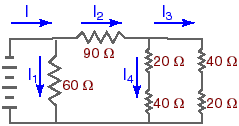Define Electric Circuits
So far we have only looked at electric charges sitting still and static discharges (like a shock or lightning). When we count on the charges moving through circuits, we start looking at electrical currents. In conductors, current flows much more easily than in the circuit elements, like switches, resistors, capacitors, inductors, diodes, etc. This area of physics has, in the less than 100 years since the discovery of the electron by J. J. Thomson, expanded into electrical engineering, which has become a course of study in its own right. But here we will just introduce you to circuit basics and later give you a taste of electronics which made today's sophisticated computers possible.
Current, the rate of the flow of charges, is measured in amperes (A). One ampere is equal to one coulomb (C) of charge passing a point in a circuit in one second. (1A = 1C/s.) You should also remember that one coulomb is a lot of charge, 1C = 6 x 1018 electrons. The arrow indicating positive current is the direction of flow of positive charge which is exactly opposite the direction of electron flow.

Voltage, or potential difference, is a measure of the work done on a charge and is measured in volts (V). The volt is named after the Italian physicist Allesandro Volta (1745 - 1827) who did research with some of the original batteries. Voltage is a measure of the energy available to produce a flow of charges through a circuit. One volt is equal to one joule of work per coulomb of charge. (1V = 1J/C). Just as heat flows through a heat conductor until there is no longer a temperature difference, charge wants to flow through an electrical conductor until there is no more potential difference (voltage). A typical battery for your radio is 1.5 volts, while the outlet in your home supplies 115 volts. The electromotive force (emf) is the potential difference when no current flows. When current flows, the potential difference between the terminals of a battery is sometimes much less than the emf because of the internal resistance of the battery.
VT = emf - I r
where VT is the potential difference in volts, emf is the electromotive force in volts (like the printed voltage on a battery), I is the current flowing from the battery in amps and r is the internal resistance of the battery in ohms.
Resistance is a measure of how difficult it is for current to flow through a circuit element. Resistance ( R) is measured in ohms (Ω). Ohms are named after a German physicist, Georg Simon Ohm, who tested different wires in circuits to see what effect the wire's resistance had on the current that would flow. Resistance is proportional to the length of the conductor, inversely proportional to the cross-sectional area of the conductor, and depends on the material used for the conductor. Gold is the best conductor and has the lowest resistance, closely followed by copper which has a bit higher resistance. Resistance is also a measure of how much of the energy of the current is converted into heat during the process of flowing. A typical power cord for the toaster has a resistance of much less than one ohm. A basic light bulb has a resistance of 100 ohms, while the toaster itself might have a resistance of 15 to 20 ohms. A circuit or path for the charges to flow from higher potential to lower potential must be provided or current will not flow.

An open circuit is one which provides no path, like an open switch. It is equivalent to an infinitely large resistance in the circuit and no current flows. A short circuit is when there is almost zero resistance in one of the paths presented to the current. You will know quickly if you accidentally do this with a wire and battery. The wire will heat up and burn your fingers, and the battery will quickly wear out! Conductivity is the inverse of resistance: the higher the resistance, the lower the conductivity. The unit for conductivity is the mho.
Capacitance is a measure of the ability to store charge and energy in electric fields. A capacitor is two conductors separated by an insulator or dielectric. Commonly used insulators are paper, mica, air, ceramic or oil. When the relative positions of the conductors can be changed, the capacitor is a variable capacitor. If a battery of voltage V is attached to the two conductors, the capacitor will build up charge until
Q = C V
where Q is the charge in coulombs, C is the capacitance in farads and V is the voltage of the battery in volts. The capacitance is proportional to the area of the conductors, inversely proportional to the distance between the conducting plates, and is dependent upon the dielectric used. The energy in joules stored in a capacitor when it is charged up to a voltage V is:
E = C V2
using Q = CV you can make this take several forms:
E = ½ CV2 = ½ QV = ½ Q2 / C